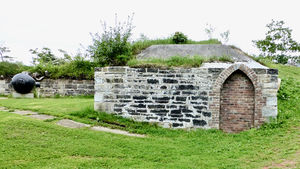Cambridge Battery
|
Cambridge Battery (1862-1918) - Cambridge Battery was a Canadian gun battery originally built for rifled muzzle-loading (RML) guns, in Halifax, Nova Scotia, Canada. Later armed with two 6-inch breech-loading (BL) guns. Named for the Duke of Cambridge, Commander of the army during much of Queen Victoria's reign. Deactivated in 1918. Also known as Fort Cambridge.
HistoryPart of the Harbor Defense of Halifax.  The Cambridge Battery was originally built for the then new rifled muzzle-loading (RML) guns. The RML guns were much more accurate and powerful than the non-rifled muzzle loaders of the past. The RML shells had brass pegs positioned on their sides that imparted spin to the shells by following the rifling groves in the gun barrel. The shells were larger and more accurate because they did not tumble through the air. Battery construction began in 1862 and it was completed on 31 Dec 1868 at a cost of 8,120 pounds. The battery was armed with three 7" RML guns and then later with five 10" RML guns.
The battery was altered in 1871-1872 to mount the five 10" RML Guns.
Sometime after 1878 two 6-inch breech-loading long guns were emplaced. The 10" RML guns were last fired at Cambridge Battery in 1904. World War I (1914-1918)At the beginning of World War II the battery was still armed with two 6-inch breech-loading guns. Dismantled in 1918, the two guns were sent to Sydney, Cape Breton Island. Current StatusThe site belongs to the Halifax City Park system, This area is now home to Shakespeare by the Sea's seasonal productions. One RML gun in place. The 6" gun emplacements are partly buried with only the upper part exposed.
See Also: Sources:
Links: Visited: 22 Jun 2013
| ||||||


